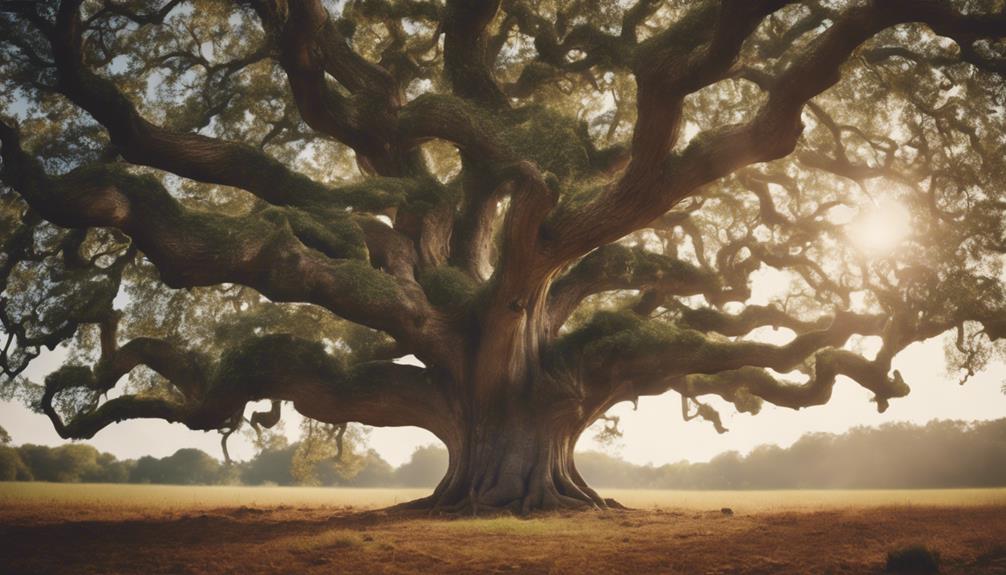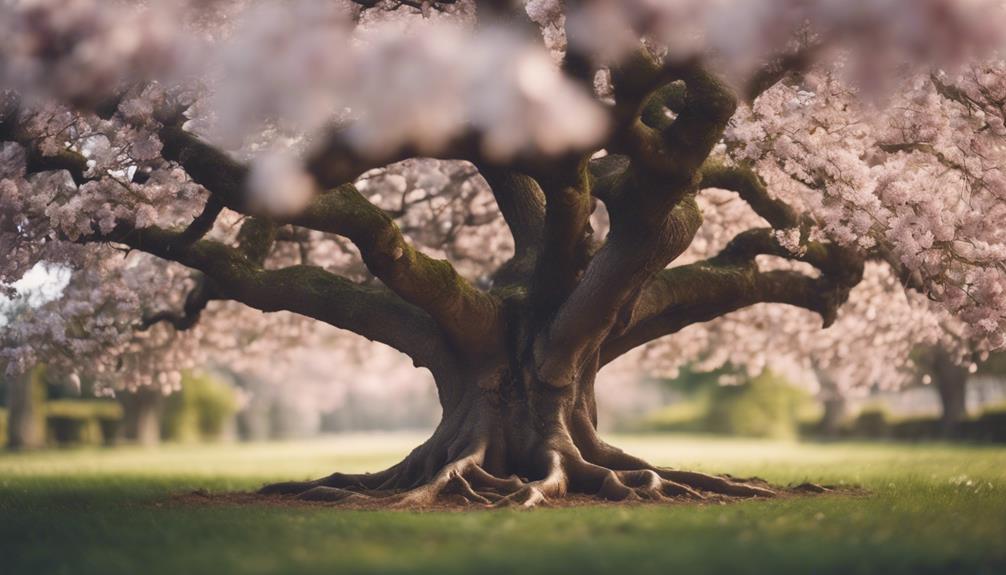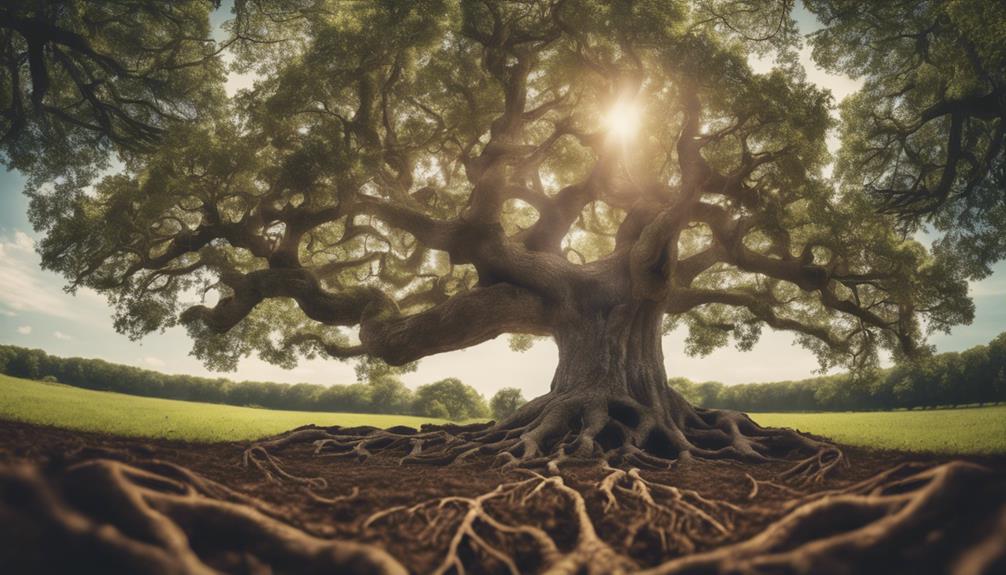Trees hold deep spiritual significance across cultures. In Christianity, the Tree of Life represents immortality and wisdom. Hinduism sees the sacred fig as a symbol of enlightenment. Judaism's Tree of Life signifies divine wisdom. Islam uses trees to connect spiritually. Trees symbolize renewal, unity, and guidance in various religions. Embracing tree symbolism uncovers profound spiritual meanings.
Key Takeaways
- Trees symbolize renewal, oneness, and divine guidance in various religions.
- Different trees like the Oak, Willow, Cedar, and Pine embody specific virtues and qualities.
- Tree symbolism imparts wisdom on life lessons and interconnectedness of all beings.
- Understanding tree symbolism guides personal growth and spiritual awareness.
- Trees serve as powerful metaphors for transformation and the cyclical nature of life.
Tree Symbolism in Various Religions
In various religions, trees hold symbolic significance representing different aspects of spirituality and divinity. Tree symbolism plays a pivotal role in conveying spiritual meaning across different faiths. For example, the Tree of Life in Christianity symbolizes immortality and divine wisdom, as depicted in Genesis and Revelation. In Hinduism, the sacred fig tree is associated with spiritual enlightenment and awakening, while in Judaism, the Torah links the Tree of Life with the teachings and wisdom of God. Islam mentions the tree of immortality in the context of the Garden of Eden, emphasizing its significance in spiritual connection.
Sacred trees in Indian religions are often found in protected groves, where they symbolize a deep spiritual connection and hold great symbolic meaning. These trees serve as reminders of the divine presence and encourage believers to seek spiritual enlightenment. The diverse interpretations of trees in various religions highlight the universal theme of seeking spiritual connection and growth through nature's symbols.
Biblical Tree Symbolism

Exploring the symbolic significance of trees in the Bible reveals profound spiritual truths and choices for humanity. In biblical tree symbolism, the Tree of Life and the tree of knowledge of good and evil carry deep spiritual meanings, representing paths of enlightenment and moral decisions. Jesus often used tree analogies to distinguish true from false prophets, highlighting the importance of discernment and wisdom in understanding biblical teachings. Additionally, figures in the Bahai Faith, such as Bahaullah and Abdul-Baha, employed tree metaphors to emphasize the unity of humanity, drawing parallels between diverse individuals and the fruits from the same source. These eternal teachings from divine Messengers guide individuals on their spiritual journey towards unity and enlightenment. The trees in religious contexts symbolize renewal, oneness, and the continuous flow of divine guidance for humanity's spiritual growth.
| Symbolism | Representation |
|---|---|
| Tree of Life | Path of enlightenment and eternal teachings |
| Tree of Knowledge | Moral choices and spiritual journey |
| Unity of Humanity | Diversity united by common spiritual source |
| Divine Messengers | Guidance and enlightenment through eternal teachings |
Islamic Tree Symbolism

Symbolizing divine provision and creation, trees in Islamic tradition carry profound spiritual significance, reflecting sustenance, shade, and beauty. The Quran mentions various trees like the date palm, olive, and fig, highlighting their importance as symbols of God's bountiful provisions. In Islamic teachings, trees are revered for their role in providing sustenance, shelter, and enhancing the earth's beauty. One notable symbolic tree in Islamic tradition is the Sidrat al-Muntaha, which represents the boundary between the created world and the divine sphere, signifying the connection between earthly existence and the spiritual realm.
Stewardship over nature and the environment holds great importance in Islam, with planting trees and caring for the earth considered virtuous acts. This concept reflects the responsibility Muslims have in preserving and protecting the environment as part of their faith. By understanding the symbolic significance of trees in Islamic tradition, one can appreciate the deeper spiritual meanings associated with these natural wonders.
Tree of Life in Judaism

Let's explore the profound significance of the Tree of Life in Judaism, a symbol rich with divine wisdom and eternal life. In Judaism, the Tree of Life holds deep spiritual significance, mentioned in the Book of Genesis as a representation of divine wisdom and eternal existence.
Within Kabbalah, the mystical branch of Jewish teachings, the Tree of Life symbolizes the universe's structure and the interconnectedness of all living beings. This sacred Tree embodies spiritual growth, enlightenment, and the journey towards God in Jewish mysticism. The Sephirot, divine emanations, are likened to branches on the Tree of Life, each reflecting different facets of God's essence.
Central to Jewish spirituality, the Tree of Life serves as a metaphor for the unity of all creation, emphasizing the pursuit of wisdom and righteousness. Its roots run deep in the teachings of Judaism, offering profound insights into the nature of existence and the divine.
Sacred Trees in Indian Religions

Sacred trees in Indian religions hold a significant place in our spiritual practices, symbolizing divine connections. These trees are revered for their association with specific deities and for their role in rituals and mythological stories.
As we explore tree worship traditions and symbolism in rituals, we uncover a rich tapestry of spiritual meanings that deepen our bond with nature and the divine.
Tree Worship Traditions
Centuries-old tree worship traditions in Indian religions deeply intertwine spiritual beliefs with the natural world, venerating trees like the Peepal, Banyan, and Neem for their sacred significance.
- The Peepal tree is revered as Lord Vishnu's abode in Hindu mythology.
- The Banyan tree symbolizes longevity and eternal life in Indian traditions.
- Neem trees are valued for their medicinal properties and purifying qualities.
These tree worship traditions, dating back centuries, reflect a profound spiritual connection to nature.
Symbolism in Rituals
Exploring the rich tapestry of Indian religious symbolism, certain trees stand as essential emblems of enlightenment, protection, and prosperity in rituals.
Sacred fig trees, such as the Peepal and Bodhi, symbolize enlightenment and immortality. The Banyan tree holds importance in mythology, representing longevity, wisdom, and protection. Neem trees are planted near homes and temples, symbolizing purification, health, and protection.
The Tulsi plant, or Holy Basil, revered in Hinduism for its healing properties, is associated with the goddess Tulsi. Mango trees, symbolizing abundance and fertility, are planted during auspicious occasions, signifying prosperity.
These trees play crucial roles in Indian rituals, enriching spiritual practices with their deep symbolism and spiritual significance. Their leaves, flowers, and even bark are often used as offerings during ceremonies, embodying purity and divine connection. Among the various creatures associated with nature’s symbolism, the spiritual symbolism of woodpeckers further deepens the reverence for these sacred trees. Woodpeckers, with their rhythmic tapping, are believed to signify persistence and the cycle of life, mirroring the timeless presence of the trees they inhabit.
Trees in Native American Spirituality

In Native American spirituality, trees hold profound significance, symbolizing connections with nature, ancestors, and the divine.
- Trees are revered as sacred beings, embodying wisdom, strength, and resilience in Native American traditions.
- They represent the interconnectedness of all life forms, emphasizing harmony and balance within the natural world.
- Rituals, ceremonies, and prayers involving trees are common practices, highlighting respect for nature and the spiritual domain.
- Trees serve as teachers and guides, offering valuable lessons in humility, gratitude, and spiritual growth to Native Americans.
The deep-rooted symbolism of trees in Native American spirituality reflects a profound respect for the natural world and the spiritual interconnectedness that binds all living beings.
Through rituals and ceremonies involving trees, Native Americans honor the wisdom and strength embodied by these sacred beings, seeking guidance and spiritual growth in harmony with the divine forces of nature.
Symbolism of Different Tree Types

Let's explore the symbolic meanings of different tree types, shedding light on the significance they hold in various cultures and spiritual practices.
From oak trees representing strength and resilience to willow trees embodying adaptability and flow, each tree type carries unique symbolism and cultural significance.
Understanding the symbolism behind these trees can offer profound insights into the values and beliefs associated with them.
Tree Symbolism Overview
Symbolizing various qualities and virtues, different tree types hold deep spiritual significance in cultures worldwide.
- Oak trees symbolize strength and endurance, embodying qualities of resilience and power.
- Willow trees are associated with intuition and longevity, reflecting adaptability and deep-rooted wisdom.
- Cedar trees signify healing and protection, offering a sense of security and spiritual guidance.
- Pine trees symbolize wisdom and longevity, representing resilience and the ability to weather life's challenges.
Trees have been revered for ages, with some like the Tree of Life appearing in various mythologies. They embody the balance between good and evil, acting as a symbol of strength and a source of life. The Tree of Immortality is associated with peace, bringing spiritual meaning to the forefront of our existence.
Sacred Tree Meanings
Exploring the symbolic essence of various tree types, we investigate the profound meanings encapsulated by sacred trees.
The Baobab tree, known as the Tree of Life, embodies emotional strength, spiritual sustenance, and a connection to the afterlife.
The Sacred Fig Tree, also referred to as the Tree of Awakening, symbolizes enlightenment, clarity, and importance in meditation practices.
The Yew tree is linked to safeguarding the soul, regeneration, and signifies transformation, death, and rebirth.
Silver Birch trees represent motherhood, new beginnings, protection, transformation, and feminine energies across cultures.
Finally, the Pomegranate tree signifies prosperity, fertility, spiritual enlightenment, wisdom, and meditation on deeper spiritual planes.
Each of these sacred tree meanings holds significant spiritual significance, offering insights into the interconnectedness between nature and spirituality.
Cultural Tree Significance
Diving into the cultural significance of different tree types, we unravel the diverse symbolism attributed to various trees across different societies and traditions.
- Oak trees symbolize strength and endurance, representing resilience and longevity in many cultures.
- Willow trees are associated with intuition and imagination, symbolizing adaptability and new beginnings.
- Cedar trees signify healing and protection, holding spiritual significance for many indigenous cultures.
- Pine trees symbolize wisdom and longevity, representing resilience and peace in various spiritual traditions.
These tree types not only beautify our landscapes but also carry deep meanings that have been passed down through generations, enriching our understanding of nature's profound connection to human experiences.
Lessons From Tree Symbolism

Tree symbolism imparts profound wisdom about life's enduring lessons and the interconnectedness of all beings. In various spiritual traditions, trees are seen as symbols of growth, resilience, and connection to nature.
Each type of tree carries specific meanings related to virtues, qualities, and life lessons. For example, the Tree of Knowledge represents the balance between good and evil, teaching us about the complexities of life. Understanding these symbolic meanings can guide us on a path of personal growth and spiritual awareness.
Trees serve as powerful metaphors for transformation, reminding us of the cyclical nature of life and the importance of endurance and adaptation. By exploring the lessons that tree symbolism offers, we gain insights into the interconnectedness of all living things, reminding us that we're all part of a greater whole.
Through trees, we learn valuable lessons that can help us navigate the complexities of life with grace and resilience.
Frequently Asked Questions
What Do Trees Symbolize Spiritually?
Trees symbolize spiritual growth, connection to the divine, and the cycle of life. They carry unique meanings in various cultures and religions, representing strength, wisdom, renewal, and protection.
Spiritually, trees embody resilience, healing, transformation, and interconnectedness. Many spiritual practices involve honoring trees, meditating near them, and using them as symbols of personal growth and enlightenment.
What Is the Spiritual Connection of Trees?
Trees hold a deep spiritual connection that resonates with our souls. Their growth and manifestation mirror our own journey of development and realization.
Just as trees bear fruits symbolizing virtues, we too must cultivate good deeds and character for personal and communal progress.
Acquiring virtues, like honesty and generosity, is essential for spiritual growth, emphasizing the significance of embodying positive qualities for a harmonious society.
What Is the Most Spiritual Tree?
When it comes to the most spiritual tree, the Baobab stands out for its deep-rooted symbolism of emotional strength, spiritual sustenance, and a connection to the afterlife.
This majestic tree, known as the 'Tree of Life,' embodies resilience and enlightenment, making it a powerful symbol in various spiritual practices.
Its significance in providing solace and spiritual guidance sets it apart as a beacon of strength and wisdom in the natural world.
What Tree Represents Healing?
When it comes to healing, the Cedar tree stands out with its symbolism of protection and restoration across diverse cultures. Its significance goes beyond physical healing, embracing spiritual and emotional well-being.
The White Willow tree also holds healing properties, deeply rooted in herbal medicine and folklore.
Eucalyptus, Olive, and Yew trees each bring their unique contributions to the concept of healing, making them essential in various traditions and practices.
Conclusion
To sum up, the spiritual significance of trees spans across various religions and cultures, each carrying their own unique meanings and symbolism.
Whether it's the Tree of Life in Judaism, sacred trees in Indian religions, or the symbolism of different tree types, trees hold lessons and wisdom that can guide us in our spiritual journey.
By understanding the deeper meanings behind trees, we can connect with nature and tap into a source of ancient wisdom that transcends time and boundaries.










